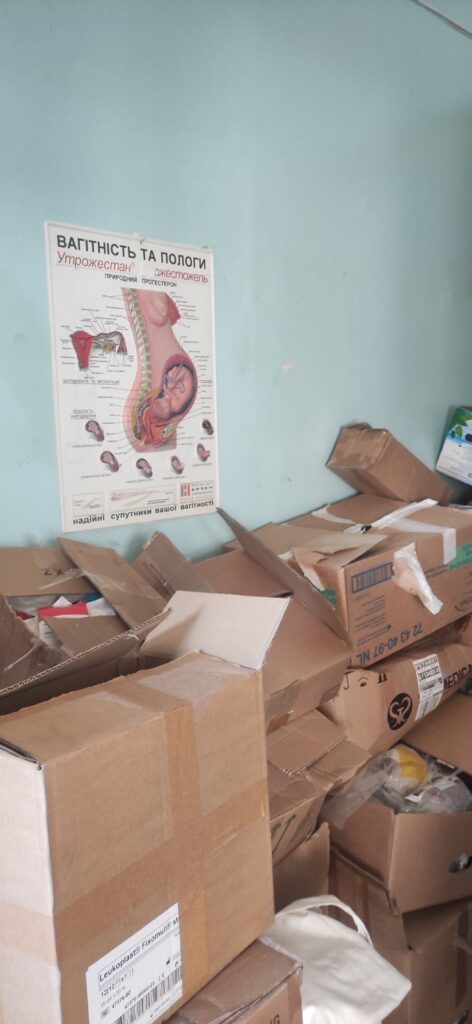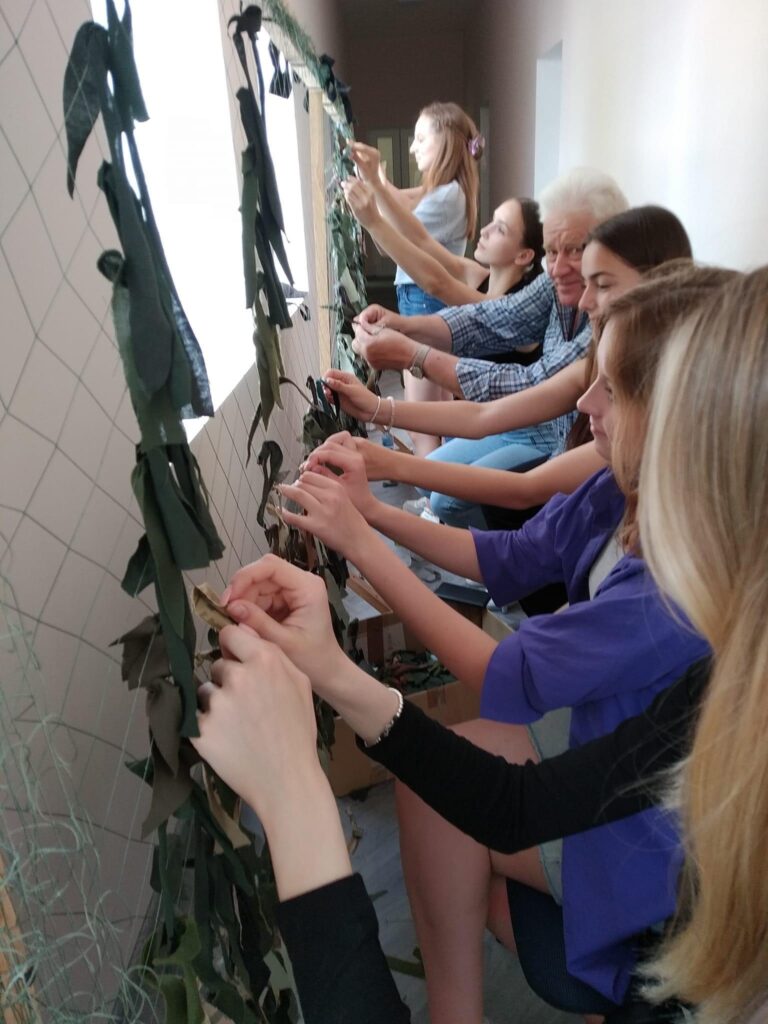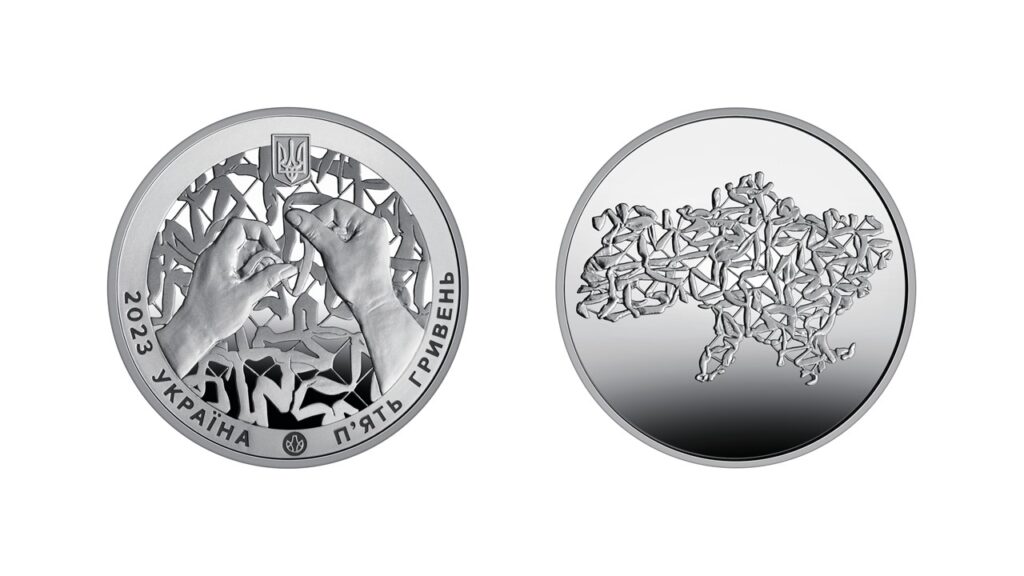This essay is about Ukrainian volunteers who create handmade camouflage nets for soldiers serving in the Ukrainian army. Their stories open new ways of thinking about care and reproduction. This kind of volunteering is a form of socially reproductive labor, and it is essential to the war relief effort. Below, I extend the notion of care from clinical settings to everyday life locations, like private residences, volunteer center courtyards, and college classrooms, all of which serve as makeshift sites for weaving camouflage nets. I show how the making of the camouflage bridges the domains of work and kinship in its constitutive capacity. The fiber woven into the camouflage is a reproductive substance, used to conceal civilians-turned-fighters from enemy weapons and thus ensure the viability and reproduction of the Ukrainian nation. Discussing war through the lenses of care, kin-making, and social reproduction can help us to gain a better understanding of human behavior in trying times.
The weaving of camouflage nets is a cultural phenomenon that has swept Ukraine since Russia’s full-scale invasion began in February 2022. Towns big and small have multiple groups who procure the needed materials, gather regularly to weave on site, or coordinate weaving by dispersed volunteer hands. One such group, in a large town in Western Ukraine, has been involved in war relief since 2014. They call themselves “Maskuty,” which is a creative take on the verb “to mask.” As of August 22nd 2024, Maskuty members have created 2,456 camouflage nets for trenches, army vehicles, evacuation buses, and one small airplane, as well as 1,638 kikimory (camouflage uniform covers). This is one of 20 volunteer groups under the umbrella of the Zakhyst organization, whose name means “Protection.” I got to know the people of Zakhyst through a childhood friend who volunteered with them in 2022 and 2023. I grew up in Ukraine and lived there till the age of twenty, when I began studying in the US.
After my family and friends first woke up to the sounds of sirens alerting them of the deadly aircrafts in the sky, early in the morning of February 24th, we spoke daily trying to reassure each other of safety. My childhood friend introduced me to other volunteers and later facilitated some of my interviews. I was invited to join their war relief efforts in person and was able to do so in the summers of 2023 and 2024. My research methods are therefore a mix of in-person and technology-mediated ethnographic techniques. During my summer visits, I got to experience different steps of the camouflage-making process and the social life of the volunteer center. I also interviewed the weavers, with varying degrees of formality and duration. Technology-mediated work began in February 2022 and is ongoing. It includes video interviews, epistolary interviews, virtual tours of the volunteer center, collection of volunteer testimonies via social media posts and press coverage, as well as our reciprocal labor of organizing and carrying out fundraising events to help build bridges between people in the US who want to provide help and people in Ukraine who need it. While the name of the volunteer group is real, the names of the participants have been replaced with pseudonyms.

Maskuty’s primary location is a former maternity hospital, where group members meet every day. Its rooms carry visible signs of the building’s rich history: bright ceiling lights in the former operation theater, tiled floors and walls in the checkup rooms, long corridors punctuated by wards that now house the volunteers. The courtyard and an auxiliary building are also used as makeshift workstations, a kitchen, a tiny outdoor cafeteria, a storage space, and even accommodations for two resident cats and sometimes kittens.
Many soldiers rely on the labor of strangers who make camouflage for them and the waiting lists are long. This is because nets are generally a single-use item: they get burnt, they get torn up or left behind, they get ruined by the elements. Maskuty makes two primary kinds of camouflage: large nets for vehicles and other military objects, known as sitky, and covers to be worn over military uniforms, known as kikimory (kiky). While the processes for making sitky and kiky are not the same, they both begin with a wooden frame that stands on the floor, its height close to that of an average adult. Volunteers work while seated on wooden benches softened with a throw or an old blanket, or while standing, often changing their positions to ease the stiffness that comes with focused and repetitive work by hand. The base net, similar to a fishing net, is hooked to small nails that outline all four sides of the wooden frame, creating a tight canvas upon which the volunteers tie strips of fabric (for sitky) or yarn (for kiky). Volunteers use what they call “medical knots” to make the uniform covers. These knots are stable and do not easily come apart, resembling surgical sutures. For larger camouflage nets that require strips of fabric, circular motion ensures that every corner of a cell is covered with fabric strips. When completed, the pattern resembles the body of a snake in motion. When one segment is filled in, two or more people carefully lift the net from the frame and repeat the process by placing the adjacent section of the blank net upon the frame. The camouflage nets are pre-measured according the soldiers’ requests. When one is completed, it is taken off the frame, checked for quality, sometimes photographed if it is of an especially astonishing size, and rolled into a tight bundle awaiting its dispatch to the front.
Kikimory require tailoring, so the completed canvas is essentially treated like fabric from which the volunteers create sleeves, bodices, hoods, and helmet covers. They stitch them together into a uniform cover with the same yarn that was used to weave the initial filled-in canvas. Variations are common for different sizes, uses, and seasons. For example, snipers may wish to have a shorter front and a longer back in their kika, like a conductor’s tuxedo, ensuring full coverage while positioned on the ground. The choice of color greatly preoccupies volunteers. It is a creative, even artistic, process of weaving with eight to ten different colors to achieve the desired seasonal camouflage effect. There are even different names for kikimory, based on their seasonal purpose: “zelenky” are green and lightweight for wooded areas in summer; “stepky” are beige for the steppe grasses in autumn; “snizhky” are white and thick for winter cover. The manual, painstaking, daily movement of so many hands rushing to complete soldiers’ requests on a tight schedule is a labor of care.

The work of producing health and saving lives in wartime is often associated with clinical settings. Indeed, health care facilities have been targeted in the war, with over 214 of them destroyed and 1,629 damaged two years into the full-scale invasion. Evacuation corridors and ambulance vehicles have been shelled, and the July 8th brutal attack on Ukraine’s main children’s hospital made international headlines. At the same time, healing depends on care “performed by laypersons outside clinical settings.” Anthropological scholarship on care in a variety of settings has shown that while care can be “carried out as a professional or commoditized activity” in places like hospitals, schools, and even salons and funeral homes, it is even more often carried out as a “material, bodily, affective, and emotional practice” typically associated with kin groups and subject to “gender- and generation-specific changes of duties and rights throughout the life-course.”
Maskuty volunteers are entangled in webs of care in multiple ways, most directly in their regular, patient, monotonous, and often invisible labor that provides a hand-made high-quality camouflage for thousands of soldiers. The labor of care also manifests in the weavers’ gift-based, even ritualistic process. Some sing, some pray, and everyone talks about the essential nature of positive thinking while weaving. A volunteer who is credited with developing and teaching the technique for kiky and sitky weaving called this benevolent orientation a “cosmic law”—sending good into the world to make a full circle and return, enriching everyone along the way. Volunteers emphasize that creating nets is not wage labor, and that nets are given away free of charge to the army units who make requests. It is common for them to donate not only time but also money when supplies are low, or to forfeit income-generating and other subsistence activities, like maintaining vegetable gardens, in favor of volunteering. For example, a flower-stand owner regularly showed up to tailor kiky and participated in weekly “Bring the Heroes Home” demonstrations advocating for Ukrainian prisoners of war, instead of selling flowers.

By the time the nets are whisked away to the frontline, it is not only the camouflage effect that is achieved, but also a sense of kinship with the soldiers whom most volunteers will likely never meet in person. Kinship is not only “lived… through care” it is also “created through care.” Volunteers who are parents sometimes refer to soldiers as children. Soldiers are also often called “khloptsi,” the Ukrainian-language word for “boys.” Consider, for example, this excerpt from an interview with a female volunteer of middle age: “The highest praise for my work is someone’s life… soldiers could be my children in terms of our age. I want them to live. I want our children to grow up here instead of looking for their fortunes abroad.” The lethal danger to which soldiers are subjected makes them eligible for the kinds of gift-based care that is more commonly reserved for children, thus reversing the generational rules of care obligations.
For example, special treats (e.g., candy, cookies, cigarettes, children’s art) are usually added to the bundles with camouflage nets travelling to the frontlines. Children sometimes take part in weaving the nets along with their grown-up family members or in school, in another example of flipping generational expectations of care. Describing the phenomenon of gift-giving, a volunteer said, “We want to do something nice for our boys… People who package the nets for delivery to the front often spend their own money to add cookies, chocolates, or cigarettes… This is a human factor. I think this is why we are still standing. Our country stands on the shoulders of people who understand this.” Other volunteers referred to this “human factor” as love, an emotion that animates kinship. Soldiers reciprocate by an occasional note or a war souvenir, like a remnant of an enemy gear. Sometimes these souvenirs are repurposed into an attractive decoration or a household item, like a coffee mug, and auctioned by volunteers, who put the funds back into the gift cycle intended to keep the army and the nation behind it afloat. According to volunteers, near-miss stories are the ultimate reward for their labor: how a van full of Ukrainian soldiers outnumbered by the enemy held their breath as Russian forces drove by without noticing them, or how a sole survivor from an ambushed group of five was the only one wearing his camouflage. One of the weavers put it this way: “We thank them, they thank us, it is so moving.”
Volunteer activities associated with weaving, such as interactions with media and the non-volunteering public, serve as a historically situated decolonial practice. Together, these aspects of volunteering demonstrate the work of social reproduction that is essential in Ukraine’s resistance to occupation. Social reproduction has been defined as “activities, attitudes, behaviors and emotions, responsibilities and relationships directly involved in the maintenance of life on a daily basis and intergenerationally.” Another way of defining social reproduction is as “the movement through which a concrete historical social reality sets the conditions for its continuity, and the way in which the concrete historical reality is embodied in agents through personal and collective identities.” Maskuty engage in socially reproductive activities by caring for soldiers through net-weaving, but also by instilling a sense of belonging and national pride through interviews with the press, social media posts, and educational outreach to students and the public. For example, one of the volunteers who teaches mathematics at the local polytechnic college has modeled civic engagement by involving her students in the making of camouflage. She installed everything needed for weaving in one of the college buildings and gave students extra credit for volunteering. She explained that this is necessary to demonstrate how citizenship works: “I think if a person does not naturally have a sense of civic duty, we need to teach it.” In an effort to shed the legacy of russification, volunteers experiment with war vocabulary. Instead of “kikimora,” a word originating in Russian language, volunteers often use Ukrainian-language alternatives – chugaister, mavka, didko. These words refer to pagan Slavic spirits, many believed to inhabit the woodlands and valleys, places not unlike the current locations of the Ukrainian forces whom the nets are called to protect.

Camouflage nets are literally intended to protect from injury and death, and figuratively intended to connect Ukrainians into a single unified nation. This idea is captured in a commemorative coin issued by Ukraine’s National Bank. It features the hands of a volunteer who is weaving a camouflage net in the shape of a map of Ukraine. In its capacity to save lives and shelter the nation, the camouflage net becomes a reproductive substance—what Edmee Baliff defines as a “substance through which kinship (and) relations … are reproduced.” Because the Russian war has targeted civilians, and because most people who picked up arms were not professional soldiers, Maskuty members understand the significance of their labor as a matter of national survival and share their worry for the future of the nation with every fallen soldier. On a personal level, volunteering can be a transformative process, linked to realization of historical injustices and decolonization. For example, one volunteer shared her experience of how her civic awareness grew:
Perhaps this war will be a reloading for the … entire nation of Ukraine… In the first days (of war) when we were sitting here and making the nets we decided we needed to do two things: learn how to shoot a gun… and read the most comprehensive history textbook cover to cover… What I mean is that… so much garbage has been force fed to us over the (Soviet) years. We need to flush it down the drain and become a true unified nation.”
Volunteers not only believe in Ukraine’s victory despite all odds, but actively plan for it. They joke that they will make special kikimory to wear to the victory parade soon. Some say they will make them pink, just for the hell of it. Some say they will make them green, the color of hope. In the last two years, Maskuty invented and perfected their weaving methods, mindful of the best camouflage effect for each landscape and season, durability and light weight of the final product, among many other things. I remember being taught how to use the palm of my hand as a guide for when to switch to a different color to avoid unnatural shapes, such as a large square patch of a single color, that could give away a soldier. I remember the weight of responsibility I felt when thinking about the stakes of my color choices. Weavers encouraged me to remember that nature does not have straight lines. Indeed, not seeing a direct path to the end of this war does not mean that peace through Ukraine’s victory is far away. When I asked one of the volunteer elders how long he plans to make camouflage nets, he did not hesitate: “till our victory.”
Maryna Nading is Professor of Anthropology in the Department of Sociology, Anthropology, and Social Work at Luther College in Decorah, Iowa.